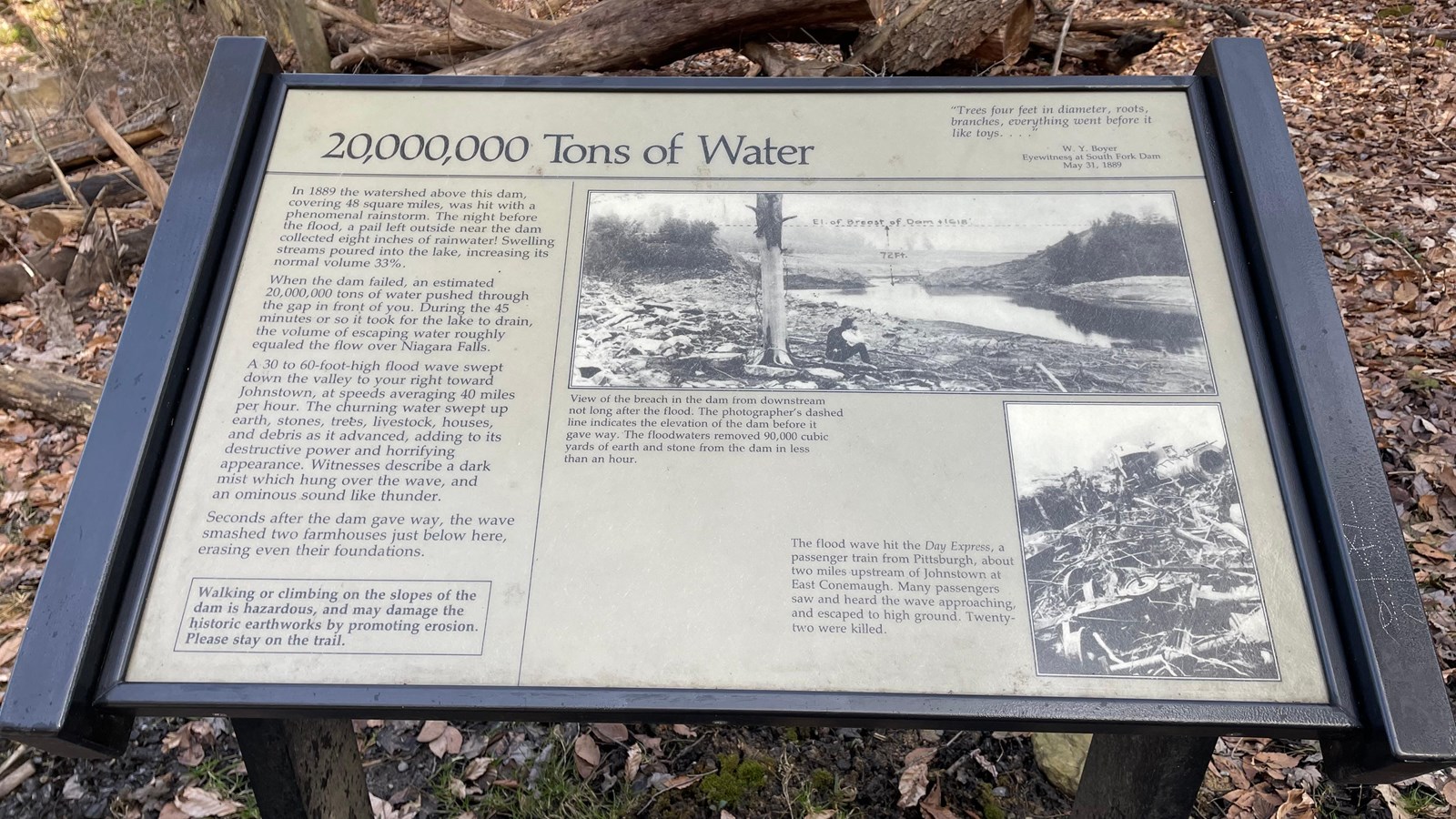Last updated: March 2, 2024
Place
"20,000,000 Tons of Water" Wayside

NPS
Quick Facts
Amenities
1 listed
Historical/Interpretive Information/Exhibits
Description of Wayside: The wayside is 36 x 24 inches and is surrounded by black metal. It has a black rectangular base with two rectangular pillars supporting the panel. The wayside along the Walk Through the Ruins trail.
Wayside Layout: The title of the wayside is at the top in large black font. In the upper right corner the text says, "Trees four feet in diameter, roots, branches, everything went before it like toys.... W. Y. Boyer, Eyewitness at South Fork Dam, May 31, 1889." The panel has a cream-colored background. There is one column of text and two images.
Wayside Title: 20,000,000 Tons of Water
Text: In 1889 the watershed above this dam, covering 48 square miles, was hit with a phenomenal rainstorm. The night before the flood, a pail left outside near the dam collected eight inches of rainwater! Swelling streams poured into the lake, increasing its normal volume 33%.
When the dam failed, an estimated 20,000,000 tons of water pushed through the gap in front of you. During the 45 minutes or so it took for the lake to drain, the volume of escaping water roughly equaled the flow over Niagara Falls.
A 30 to 60-foot-high flood wave swept down the valley to your right toward Johnstown, at speeds averaging 40 miles per hour. The churning water swept up earth, stones, trees, livestock, houses, and debris as it advanced, adding to its destructive power and horrifying appearance. Witnesses describe a dark mist which hung over the wave, and an ominous sound like thunder.
Image: View of the breach in the dam from downstream not long after the flood. The photographer's dashed line indicates the elevation of the dam before it gave way. The floodwaters removed 90,000 cubic yards of earth and stone from the dam in less than an hour.
Image: The flood wave hit the Day Express, a passenger train from Pittsburgh, about two miles upstream of Johnstown at East Conemaugh. Many passengers saw and heard the wave approaching, and escaped to high ground. Twenty-two were killed.
Walking or climbing on the slopes of the dam is hazardous, and may damage the historic earthworks by promoting erosion. Please stay on the trail.
Wayside Layout: The title of the wayside is at the top in large black font. In the upper right corner the text says, "Trees four feet in diameter, roots, branches, everything went before it like toys.... W. Y. Boyer, Eyewitness at South Fork Dam, May 31, 1889." The panel has a cream-colored background. There is one column of text and two images.
Wayside Title: 20,000,000 Tons of Water
Text: In 1889 the watershed above this dam, covering 48 square miles, was hit with a phenomenal rainstorm. The night before the flood, a pail left outside near the dam collected eight inches of rainwater! Swelling streams poured into the lake, increasing its normal volume 33%.
When the dam failed, an estimated 20,000,000 tons of water pushed through the gap in front of you. During the 45 minutes or so it took for the lake to drain, the volume of escaping water roughly equaled the flow over Niagara Falls.
A 30 to 60-foot-high flood wave swept down the valley to your right toward Johnstown, at speeds averaging 40 miles per hour. The churning water swept up earth, stones, trees, livestock, houses, and debris as it advanced, adding to its destructive power and horrifying appearance. Witnesses describe a dark mist which hung over the wave, and an ominous sound like thunder.
Image: View of the breach in the dam from downstream not long after the flood. The photographer's dashed line indicates the elevation of the dam before it gave way. The floodwaters removed 90,000 cubic yards of earth and stone from the dam in less than an hour.
Image: The flood wave hit the Day Express, a passenger train from Pittsburgh, about two miles upstream of Johnstown at East Conemaugh. Many passengers saw and heard the wave approaching, and escaped to high ground. Twenty-two were killed.
Walking or climbing on the slopes of the dam is hazardous, and may damage the historic earthworks by promoting erosion. Please stay on the trail.
